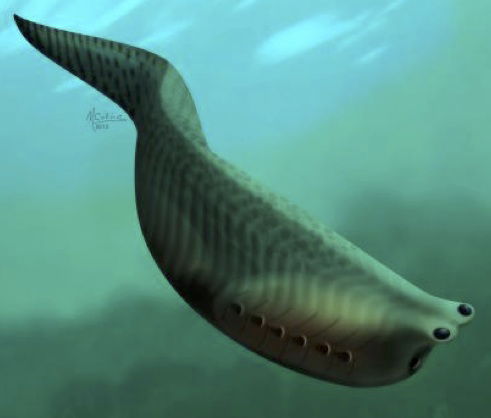
Jaw-Dropping Discovery in the Burgess Shale
News to Know
Abstract
Did this little fish lose a gill to build a jaw for its evolutionary descendants?
News Source
- Slate: “Chew On This Fantastic New Fossil”
A thumb-sized fish from the Cambrian layers of the Burgess Shale is making big headlines for what it lacks. Does the absence of gills on the first of its seven branchial arches mean that over 500 million years ago Metaspriggina walcotti was taking the first transitional step toward the evolution of a jaw? Evolutionists think so.
The First Branchial Bar
Fish gills are supported by branchial bars (aka branchial arches) of bone or cartilage. Some—those that evolutionists consider “primitive”—have seven single branchial bars. In others the branchial bars consist of seven hinged pairs. Evolutionists believe that transition from a continuous arch to hinged bipartite arch was a step toward development of the hinged jaw. In the embryos of jawed fish, the first two arches develop into the fish’s jaw, so they think the embryologic process recapitulates evolutionary history.
Well-preserved Metaspriggina fossils from the newly discovered additional fossil beds in Canada’s Burgess Shale have gill filaments associated with each arch “except perhaps along the anterior-most set,”1 paleontologists Simon Conway Morris and Jean-Bernard Caron write. Therefore, the evolutionary paleontologists believe loss of gills from Metaspriggina’s first branchial bar was a crucial transitional step in jaw evolution.

This is an artist’s reconstruction of Metaspriggina, a thumb-sized jawless fish whose fossils are well-preserved in Cambrian rock. One of the skeletal arches near its gills lacks gills, so evolutionary researchers propose that Metaspriggina was beginning an evolutionary transition toward the formation of a jaw. Image by Marianne Collins copyright Conway Morris and Caron, via Slate
Several other aspects of Metaspriggina’s anatomy prompt those with an evolutionary worldview to suggest Metaspriggina is a transitional vertebrate that unveils the ancestry of the jaw. In addition to the fact that the arches are bipartite and the lack of gills on the first, the first arch is thicker than the others and, they think, homologous to the vertebrate mandible. Also gill placement seems external to each arch as in jawed fish; extant jawless fish have gills located interior to these cartilaginous supports.1
Without jaws to open its mouth, Metaspriggina was probably a filter feeder, sucking up debris and filtering it for edibles. Caron thinks the branchial bars may have helped increase the water flow and therefore the feeding efficiency of the fish.2
Predicted Transition?
In “A primitive fish from the Cambrian of North America” published in Nature, Morris and Caron describe Metaspriggina’s advanced anatomical traits—an eye lens and modern musculature. They are most excited however because Metaspriggina fulfills evolutionary predictions for what the ancestor of a jawed vertebrate should look like. Caron says Metaspriggina’s branchial bars were “a staging post in the evolutionary story of vertebrates.”
“The configuration of the branchial bars and associated gills in Metaspriggina has three wider implications,” they write. “The first is that this arrangement recalls their frequently invoked ancestral configuration, even though this is usually regarded as hypothetical. Primitive serial homology is often used as a starting point in discussions on the origin of jaws, although Metaspriggina is too basal to be directly informative”1 (emphasis ours). Morris says, “Everyone said it should have never been found. It looks remarkably like the hypothetical animal that we’d talked about.”
Cambrian History
Metaspriggina was previously known from only a few fragments discovered in Burgess Shale about a century ago. The new fossils, including some with exquisitely preserved soft body parts like gill filaments, were excavated from the newly discovered Canadian Burgess Shale sites we described in March. (See “Canada’s New Cambrian Explosion: Burgess Shale Chapter Two” for more details and maps.) Most are from sites near Kootenay National Park’s Marble Canyon3 on a mountainous outcrop in British Columbia. They are from Cambrian rock assigned dates of 505 to 515 million years ago.
This is indicative of the rapid burial of vast numbers of marine creatures.
Smithsonian director Charles Walcott found the now-famous fossil-rich exposed outcrop of Cambrian rock on Canada’s Mount Stephan in 1909. He collected over 80,000 Cambrian fossils from this Burgess Shale between 1910 and 1917. Many of these well-preserved fossils also have counterparts in Cambrian rock in China. A new chapter in the Burgess Shale story began with discovery of new fossil-rich sites at undisclosed locations in British Columbia. One of the most remarkable aspects of Cambrian fossil graveyards, conventionally dated around 505 to 542 million years ago, is the exquisite preservation of anatomical soft structures as fossils. This is indicative of the rapid burial of vast numbers of marine creatures.
The “Cambrian explosion”—seen in the Burgess Shales and similar deposits unearthed by erosion in China—refers to the abrupt and seemingly simultaneous appearance of a diverse array of complex animals in the fossil record. All major animal body plans are represented. Evolutionists are hard-pressed to explain how evolution suddenly produced vast numbers of complex invertebrates and vertebrates without the requisite antecedent more primitive forms. Biological science has never shown animals evolving into new more-complex kinds of animals. The belief that they did is a result not of scientific observation but of the worldview-based belief that all organisms had to evolve from less-complex ones through natural processes.
The majority of Cambrian fossils are invertebrates, but Metaspriggina is an extinct cartilaginous vertebrate fish. Its “backbone” consists of a notochord instead of vertebral bones. The word notochord refers to a rod supporting the central nerve cord of some rare living creatures like lancelets (an eel-like marine worm) and the extinct eel-like Pikaia as well as to a similar structure that temporarily functions as a place-holder for developing vertebral bones in vertebrate embryos. (Caron and Morris have also published studies on the Burgess Shale Pikaia. See “Common Ancestor Hidden in Burgess Shale.”)
Advanced Anatomy
Metaspriggina’s eye contains a well-defined circle suggesting a lens, generally considered an advanced feature in eye evolution. The W-shaped arrangement of Metaspriggina’s muscles segments alongside the notochord is typical of that seen in fast-moving modern fish.
Metaspriggina’s streamlined fish body with muscles ready for a race and prominent eyes sticking up above its head—the better to see what’s coming—was well-equipped to avoid predators. Its circumspect vision and speedy construction could do nothing, however, to enable these Metaspriggina specimens to avoid the tons of sediment stirred up when the global Flood began about 4,300 years ago, rapidly burying them and countless other marine creatures living near the sea bottom—likely among the first casualties of the greatest cataclysm the earth has ever seen.
The fact that this little fish has many “advanced” traits as well as a gill-less first branchial arch does not mean it was transitioning into some new more complex kind of animal. As the authors note, it is popular for evolutionists to line up organisms possessing various traits and then connect the dots and fill in hypothetical creatures where needed. The discovery of a fossil to fit their hypothetical creature does not mean it is a transitional form, however. It only means that it is a fish with particular characteristics, not that the fish was an evolutionary stepping stone from one kind of fish to another kind.
Fishing Deeper in the Fossil Record
This fairly “advanced” fish—in terms of eyes and muscles—so deep in the fossil record is not becoming the poster-fish for unexplained Cambrian advancements but is rather being exploited as an evolutionary step toward more “advanced” organisms, even humans. In an evolutionary scenario, how did this fish get is modern eyes and musculature?
Commenting of this Cambrian fish, Answers in Genesis geologist Dr. Andrew Snelling says:
It wasn’t long ago that we were told fish evolved in the Devonian, because there were no fish fossils lower in the record. Then we were told fish fossils had been found in Silurian strata and subsequently in Ordovician strata. Now we see yet another report of fish fossils found in Cambrian strata, adding to the so-called Cambrian explosion, which is such an enigma and embarrassment to evolutionists. They are now struggling to explain where even more ancestors of these creatures are in the fossil record, and how all the body plans of so many phyla suddenly came into existence by supposed explosive evolution in a virtual geologic instant, with no hint of their ancestors in the rock layers below.
The observable evidence in fact makes far more sense if all these Cambrian creatures, including these fish, were all buried at the same time, at the onset of a catastrophic event when the ocean waters were rising to flood the continents. Even evolutionists admit the ocean waters eroded their way across the continents at the beginning of the Cambrian as they rose to eventually flood the continents. This is totally consistent with the Bible’s description of the onset of the Genesis Flood. It means there were no ancestors, just creatures all alive at the same time, progressively buried rapidly as the ocean waters rose catastrophically. The absence of certain creatures as fossils at any particular level in the fossil record is not evidence that those creatures didn’t exist at that time, just that they weren’t buried then.
This conclusion is further substantiated by the way these particular fish fossils have been so rapidly buried to be so exquisitely preserved. If they weren’t buried catastrophically, they would have rotted before burial.
Embryonic Recapitulation
Evolutionists don’t stop the jaws-of-life story with fish. Even though embryonic recapitulation theory—the idea that embryonic development is a record of evolutionary history—was laid to rest long ago, it has never rested well. Like a zombie it is routinely resurrected to support evolutionary contentions. Thus Metaspriggina is being seen as the first evolutionary step toward the formation of our jaw. Caron points out that in humans some of these gill bars form the jaw and others turn into the bones of the middle ear. He says, “We're quite thrilled and we anticipate many new important specimens for understanding our roots.”2
Evolutionists maintain that the pharyngeal arches in vertebrate embryos of all types are anatomical throwbacks to a fishy evolutionary past. Pharyngeal (aka branchial) arches in vertebrate embryos are mounds of multiplying cells along the neck. They differentiate into the anatomical structures designated in the embryo’s DNA. Pharyngeal arches in human embryos become parts of the jaw, face, ear, middle ear bones, and voice box. Only in fish do these embryonic arches differentiate in the components of gills and their structural supports. And only in fish do these structures have any sort of respiratory function.
This is a typical instance of inappropriately drawing evolutionary conclusions from embryological development.
This is a typical instance of inappropriately drawing evolutionary conclusions from embryological development. Embryonic development, however, is the observable DNA-blueprinted way the structures in a particular species differentiate. Evolutionary advancement is the never-observed transition of the anatomy of one kind of organism into the new and more complex part of a completely different kind of organism. You can read more about problems with this claim in “Review: Your Inner Fish” and “Recapitulation Theory: Repackaged & Re-Applied.”
Real History Matches Real Observational Science
The biblical account of Creation tells us that God created animals to reproduce after their kinds, and biological observation confirms that they do just that, not evolve into other kinds of animals. The biblical account of the global Flood explains the rapid burial and preservation of soft body parts in the Cambrian explosion and the presence of organisms with so-called advanced features. The evolutionary researchers are delighted to have discovered a transitional fossil they “predicted” but fail to mention that evolutionary models do not explain the presence of modern musculature, eye lenses, or even fish in the Cambrian rock. Despite claims to the contrary Metaspriggina is just an interesting fish, not the first step on the path to jaws, much less to a human evolutionary endpoint 500 million years later.
Further Reading
- The Eyes Have It
- Review: Your Inner Fish
- Canada’s New Cambrian Explosion: Burgess Shale Chapter Two
- Common Ancestor Hidden in Burgess Shale
- Burgess Shale’s Cambrian Fossils Should Change Our View of Evolution
- Recapitulation Theory: Repackaged & Re-Applied
- Fascinating Cuttlefish
For More Information: Get Answers
Remember, if you see a news story that might merit some attention, let us know about it! (Note: if the story originates from the Associated Press, FOX News, MSNBC, the New York Times, or another major national media outlet, we will most likely have already heard about it.) And thanks to all of our readers who have submitted great news tips to us. If you didn’t catch all the latest News to Know, why not take a look to see what you’ve missed?
(Please note that links will take you directly to the source. Answers in Genesis is not responsible for content on the websites to which we refer. For more information, please see our Privacy Policy.)
Footnotes
- S. Morris and J. Caron, “A primitive fish from the Cambrian of North America,” Nature (2014), doi:10.1038/nature13414.
- Emily Chung, “Ancient Rockies Fish Fossils Reveal Origin of Jaws,” CBC, June 11, 2014, www.cbc.ca/news/technology/ancient-rockies-fish-fossils-reveal-origin-of-jaws-1.2672157.
- Others are from three Cambrian Burgess Shale-type deposits from Laurentia.
Recommended Resources

Answers in Genesis is an apologetics ministry, dedicated to helping Christians defend their faith and proclaim the good news of Jesus Christ.
- Customer Service 800.778.3390
- © 2024 Answers in Genesis




